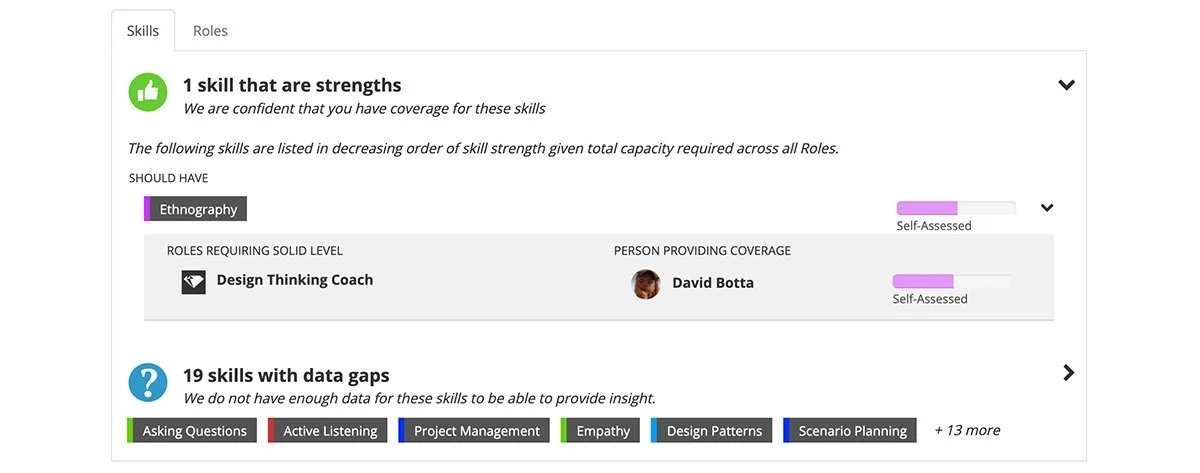Core Concepts: Role Coverage
By Gregory Ronczewski, Director of Product Design at Ibbaka. See his skill profile.
Definition of Role Coverage
Most of us understand Role and Coverage, but what does it mean when the two terms are used together? Let’s begin by looking a bit deeper into standard definitions of these terms.
Coverage
1 something that covers: such as
a: inclusion within the scope of an insurance policy or protective plan
b: the amount available to meet liabilities
c: inclusion within the scope of discussion or reporting
2 the total group covered
a: all the risks covered by the terms of an insurance contract
b: the number or percentage of persons reached by a communications medium
3 the act or fact of covering
Merriam Webster: Coverage
Role
1 a: (1) a character assigned or assumed
(2) a socially expected behaviour pattern usually determined by an individual's status in a particular society
b: a part played by an actor or singer
2 a function or part performed especially in a particular operation or process
Role coverage for the individual
When one combines the two the concept of role coverage comes to life. One of the most important functions of the Ibbaka Talent Platform is to provide an understanding of role coverage. It is fantastic to create a rich skill profile, designate skills as Core or Targeted, and share with team members and colleagues, but we should not stop there.
By layering in insights and understanding of how a skill profile compares to role requirements—either current or aspired—a host of new possibilities open up. This comparison, assessment, or simply role coverage uncovers skill gaps. We have a post on skill gap in the Core Concepts series. Role coverage gives both individuals and managers a view of strengths and weaknesses and, above all, opportunities for improvement and new positions. It helps managers to:
Know if we are considering the right people for the right roles
Know if everyone on the team has the skills they need to be successful
Identify people on the team who may be best suited to mentor others in a specific skill
Identify and target skill sets that may help the team perform better
It is quite simple to initiate the process. Once a few roles are defined with critical skills or must-have skills (apart form must-have, we also have should-have category), the platform constructs a view showing whether team members have those skills even if they did not specify that particular skill as part of their role. The system allows the manager to change capacity or the number of best matching people to fulfill the role requirements.
Role coverage for the organization
There is a second way to think about role coverage. When planning for growth we often want to know if we have enough people with the right skills to fill the roles we need. Here the questions are
Do we have enough people to fill the roles we require to achieve our goals and to meet our growth targets?
What combinations of people could we use to fill these roles?
What interventions will have the most impact on improving role coverage?
Share your thoughts on role coverage and how to measure it
What are your thoughts on role coverage? How many roles do you need to fill in your current position? How about your aspirations - do you have a dream role? Join Ibbaka Talent and find out how far you are from achieving your dreams.
More posts on Role Coverage and Skill Gap Analysis
How should your organization measure role coverage and skill gaps?
Why Role Coverage and Skill Gap Analysis is Mission Critical
Core Concepts: Role Coverage (this post)
How is your organization collecting and using data about skill gaps?
How to Understand Skill Coverage for Key Roles in Your Organization - Ibbaka Demo
Core Concepts: Skill Management and Competency Modelling
Role Coverage (this post)
Competency Framework and Competency Model
Coming soon …
Skill Assessment
Core Concepts: Pricing and Customer Value Management
Coming soon …
Value Driver
Economic Value Driver
Emotional Value Driver
Community Value Driver
Value Model
Pricing Model
Connecting Value and Pricing Models
Pricing Design
Package Design
Price Elasticity of Demand
Cross Price Elasticity
Interactions of Cross Price Elasticity and Price Elasticity of Demand
Value Based Market Segmentation
Value Path
Lifetime Value of a Customer (LTV)
Value to Customer (V2C)
Value Ratio
Economic Value Estimation (EVE)
Willingness to Pay (WTP)
Pocket Price Waterfall
Customer Value Journey
Customer Value Management



